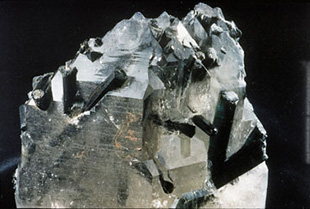












Tourmaline belongs to the trigonal crystal system and occurs as long, slender to thick prismatic and columnar crystals that are usually triangular in cross-section. Interestingly, the style of termination at the ends of crystals is asymmetrical, called hemimorphism. Small slender prismatic crystals are common in a fine-grained granite called aplite, often forming radial daisy-like patterns. Tourmaline is distinguished by its three-sided prisms; no other common mineral has three sides. Prisms faces often have heavy vertical striations that produce a rounded triangular effect.
Tourmaline is rarely perfectly euhedral. An exception was the fine dravite tourmalines of Yinnietharra, in western Australia. The deposit was discovered in the 1970s, but is now exhausted.
Tourmaline has a wide variety of colors. Usually, iron-rich tourmalines are black to bluish-black to deep brown, while magnesium-rich varieties are brown to yellow, and lithium-rich tourmalines are practically any color: blue, green, red, yellow, pink etc. Rarely, it is colorless. Bi-colored and multicolored crystals are relatively common, reflecting variations of fluid chemistry during crystallisation.
Crystals may be green at one end and pink at the other, or green on the outside and pink inside: this type is called watermelon tourmaline. Some forms of tourmaline are dichroic, in that they appear to change color when viewed from different directions.
The most common variety of tourmaline is schorl. It may account for 95% or more of all tourmaline in nature. The early history of the mineral schorl shows that the name "Schorl" was in use prior to the year 1400 (AD) because a village known today as Zschorlau (in Saxony, Germany) was then named "Schorl" (or minor variants of this name). This village had a nearby tin mine where, in addition to cassiterite, a lot of black tourmaline was found. The first relatively detailed description of schorl with the name "schürl" and its occurrence (various tin mines in the Saxony Ore Mountains) was written by Johannes Mathesius (1504-1565) in 1562 under the title "Sarepta oder Bergpostill" (Ertl, 2006). Up to about 1600, additional names used in the German language were "Schurel", "Schörle", and "Schurl". From the 18th century on, the name "Schörl" was mainly used in the German-speaking area. In English, the names "shorl" and "shirl" were used in the 18th century for schorl. In the 19th century the names "common schorl", "schörl", "schorl" and "iron tourmaline" were used in the Anglo-Saxon area (Ertl, 2006). The word tourmaline has two entymologies, both from the Sinhalese word turamali, meaning "stone attracting ash" (a reference to its pyroelectric properties) or according to other sources "mixed gemstones". The meaning of the word "schorl" is a mystery, but it may be a Scandinavian word.
By Appointment
DE FERRANTI
South Park Studios - Suite 10
88 Peterborough Road, London SW6 3HH
United Kingdom